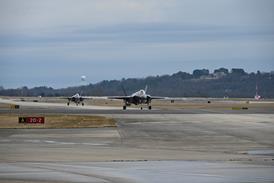President and chief executive Jack Pelton leads business jet revival with a global perspective and a swathe of new products
Among business aircraft manufacturers, Cessna is experiencing one of the strongest recoveries as the market bounces back from last year's low point. This is good news for Jack Pelton, who joined Cessna in late 2000, just as business jet deliveries peaked, and was named president and chief executive last December, just as they hit bottom.
In a sure sign that a recovery is under way, Cessna booked 72 net Citation orders in the third quarter and another 41 last month at the showcase National Business Aviation Association (NBAA) show in Las Vegas, Nevada. "We are emerging from a downturn with unprecedented momentum," says Pelton.
At NBAA, Cessna was the first manufacturer to welcome the recovery by introducing new products - the improved Citation CJ1+ and CJ2+ light jets - a clear sign that Pelton intends to honour the history of aggressive product development that has made Cessna the leading producer of entry-level to mid-size business jets.
"We have certificated 17 new aircraft in the last 10 years. No-one else comes even remotely close," says Pelton. "We continue to invest and to innovate, because the doldrums are only temporary." The commitment is not only to products. Through the downturn of the last two years Cessna invested $100 million in new US service centres.
NBAA was confirmation, if it was needed, that Cessna is steering a steady course under its new leader. Compared with industry legend Russ Meyer, chief executive from 1975 to 2000 and again from June 2002 to March 2003, Pelton was relatively unknown outside the company when he was named to replace Charlie Johnson, who was forced by illness to retire after only a few months as chief executive.
Whereas Meyer and Johnson were both long-time Cessnans, Pelton had been with the Wichita, Kansas-based company a little over three years. The perspective he brings from his experience with other aircraft manufacturers could prove influential to a company with a history of self-sufficiency.
A pilot and product of a flying family - "Cessnas, of course" - Pelton spent 20 years at Douglas. "I worked on the MD-90 and learned a lot about new product development and project management. When I moved to the 717 I gained experience of international collaboration, and of doing things differently to bring a product to market with lower investment," he says.
Pelton then moved to Fairchild Dornier, where the goal was to create a family of regional jets "and to take the company public or sell it". The latter was achieved with the December 1999 sale to investment firm Clayton, Dubilier & Rice, but the former was frustrated by Fairchild Dornier's bankruptcy in April 2002, by which time Pelton was Cessna's senior vice-president of engineering.
"Cessna was looking for someone to lead engineering, flight test and programmes. Milt Sills, an icon in the industry and a piece of Cessna history, was getting ready to retire. What I brought was a different perspective - a global perspective - and experience of international collaboration."
While rival business jet manufacturers, including Wichita neighbour Raytheon, have turned to risk-sharing partners, Pelton cautions against expecting Cessna to embrace the concept as extensively - despite his own experience with international participation.
"A lot is done for specific strategic reasons by companies that do not have the wherewithal to bring a new product to market themselves. We are unique at Cessna. We have not been dependent on external investment and external companies to continue to invest." Cessna is owned by Textron.
This year alone, the company has certificated seven aircraft, including the mid-size Sovereign - its first all-new business jet since the Mach 0.92 Citation X was approved in 1996. Its next all-new jet, the entry-level Mustang, is taking shape, with the fuselage for the first aircraft under assembly. First flight is due next year, with first delivery set for late 2006.
Pelton's decision to join Cessna "revolved around the fact the company was very thoughtful in making sure it continued to invest in products". He points to Cessna's launch of the Mustang in 2002, when the industry was in the grip of the downturn, and the significant investment in upgrading its single-engine product line.
With the recovery gathering pace, speculation is beginning to swirl around Cessna's next major product launch. The CJ1+ and CJ2+ are relatively modest upgrades of the CitationJet, using technology from the recently certificated CJ3, and as the Mustang progresses engineering resources for bigger projects will become available.
Pelton makes no secret of Cessna's desire to develop a supersonic business jet (SSBJ) ; its Citation X is the fastest civil aircraft in service following Concorde's retirement. While the company is unlikely to develop an SSBJ on its own, equally, it is expected to be involved in any such development.
A supersonic Cessna may still be years away, but under Pelton's leadership the company looks set to continue, and even accelerate, its industry-leading product development strategy. "We will continue to invest as we have done in good times and bad times in products and services," he says.
GRAHAM WARWICK / WASHINGTON DC
Source: Flight International























